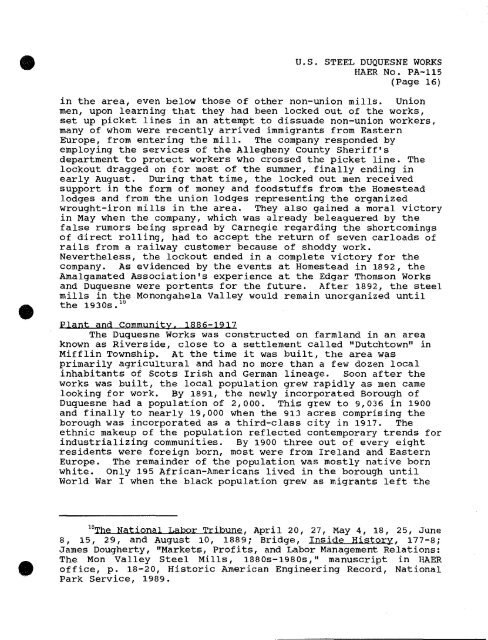pa1778data.pdf
pa1778data.pdf
pa1778data.pdf
Create successful ePaper yourself
Turn your PDF publications into a flip-book with our unique Google optimized e-Paper software.
•<br />
U.S. STEEL DUQUESNE WORKS<br />
HAER No. PA-115<br />
(Page 16)<br />
in the area, even below those of other non-union mills. Union<br />
men, upon learning that they had been locked out of the works,<br />
set up picket lines in an attempt to dissuade non-union workers,<br />
many of whom were recently arrived immigrants from Eastern<br />
Europe, from entering the mill. The company responded by<br />
employing the services of the Allegheny County Sheriff's<br />
department to protect workers who crossed the picket line. The<br />
lockout dragged on for most of the summer, finally ending in<br />
early August. During that time, the locked out men received<br />
support in the form of money and foodstuffs from the Homestead<br />
lodges and from the union lodges representing the organized<br />
wrought-iron mills in the area. They also gained a moral victory<br />
in May when the company, which was already beleaguered by the<br />
false rumors being spread by Carnegie regarding the shortcomings<br />
of direct rolling, had to accept the return of seven carloads of<br />
rails from a railway customer because of shoddy work.<br />
Nevertheless, the lockout ended in a complete victory for the<br />
company. As evidenced by the events at Homestead in 1892, the<br />
Amalgamated Association's experience at the Edgar Thomson Works<br />
and Duquesne were portents for the future. After 1892, the steel<br />
mills in the Monongahela Valley would remain unorganized until<br />
the 1930s. 18<br />
Plant and Community. 1886-1917<br />
The Duquesne Works was constructed on farmland in an area<br />
known as Riverside, close to a settlement called "Dutchtown" in<br />
Mifflin Township. At the time it was built, the area was<br />
primarily agricultural and had no more than a few dozen local<br />
inhabitants of Scots Irish and German lineage. Soon after the<br />
works was built, the local population grew rapidly as men came<br />
looking for work. By 1891, the newly incorporated Borough of<br />
Duquesne had a population of 2,000. This grew to 9,036 in 1900<br />
and finally to nearly 19,000 when the 913 acres comprising the<br />
borough was incorporated as a third-class city in 1917. The<br />
ethnic makeup of the population reflected contemporary trends for<br />
industrializing communities. By 1900 three out of every eight<br />
residents were foreign born, most were from Ireland and Eastern<br />
Europe. The remainder of the population was mostly native born<br />
white. Only 195 African-Americans lived in the borough until<br />
World War I when the black population grew as migrants left the<br />
18 The National Labor Tribune, April 20, 27, May 4, 18, 25, June<br />
8, 15, 29, and August 10, 1889; Bridge, Inside History, 177-8;<br />
James Dougherty, "Markets, Profits, and Labor Management Relations:<br />
The Mon Valley Steel Mills, 1880s-1980s," manuscript in HAER<br />
office, p. 18-20, Historic American Engineering Record, National<br />
Park Service, 1989.

















